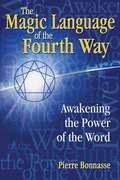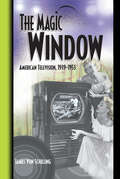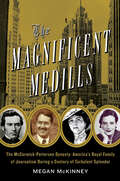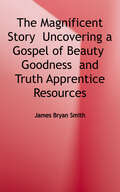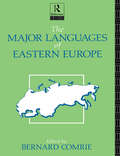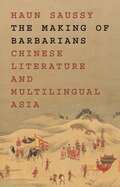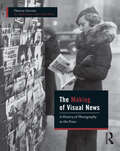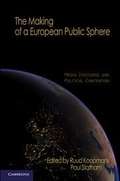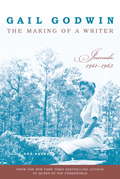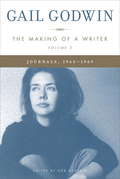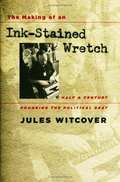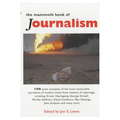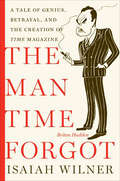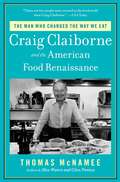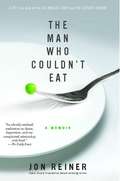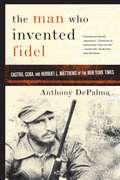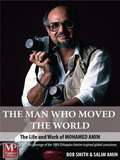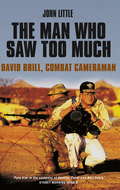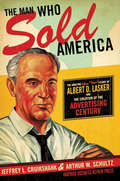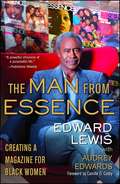- Table View
- List View
The Magic Language of the Fourth Way: Awakening the Power of the Word
by Pierre BonnasseAn application of Gurdjieffian principles to fully and properly activate the power of language • Explains the relationship between the Gurdjieff enneagram and sacred geometry and harmonics • Shows that the objective power of language--and art and music--lies in the ability to use symbols that will mean precisely the same thing to anyone • Includes a new English translation of René Daumal’s essay “The Holy War” In The Magic Language of the Fourth Way, Pierre Bonnasse applies the esoteric teachings of Fourth Way mystic G. I. Gurdjieff and the insights of initiate René Daumal to show how to fully and properly activate the power of language. Bonnasse shows how words can regain the strange magical powers they possessed in the first days of humanity, when words created the realities of what they described. This is a far cry from today’s world in which even writers lament the impotent nature of language.Bonnasse uses the relationship between the Gurdjieff enneagram and sacred geometry and harmonics to reveal the power given to words by the notes of the scale. He shows not only how to discover the objective power of words but also how to apply the relationship between language and living to maximum effect. He explains that the objective power of language--and art and music--lies in the ability to use symbols that will mean precisely the same thing to anyone. The Magic Language of the Fourth Way serves as a clear and generous introduction to the complexities of Gurdjieffian thought as well as a descriptive how-to manual for Fourth Way aspirants on the uses of objective language for spiritual advancement.
The Magic Window: American Television ,1939-1953
by Jim Von SchillingFirst published in 2002. Routledge is an imprint of Taylor & Francis, an informa company.
The Magnificent Medills: The McCormick-Patterson Dynasty: America's Royal Family of Journalism During a Century of Turbulent Splendor
by Megan McKinneyThe riveting story of the country’s first media dynasty, the Medills of Chicago, whose power and influence shaped the story of America and American journalism for four generations When thirty-two-year-old former lawyer Joseph Medill bought a controlling stake in the bankrupt Chicago Daily Tribune in 1855, he had no way of foreseeing the unparalleled influence he and his progeny would have on the world of journalism and on American society at large.Medill personally influenced the political tide that transformed America during the midnineteenth century by fostering the Republican Party, engineering the election of Abraham Lincoln and serving as a catalyst for the outbreak of the Civil War. The dynasty he established, filled with colorful characters, went on to take American journalism by storm. His grandson, Colonel Robert R. McCormick, personified Chicago, as well as its great newspaper, the Chicago Tribune, throughout much of the twentieth century. Robert’s cousin, Joseph Medill Patterson, started the New York Daily News, and Joe’s sister, Cissy Patterson, was the innovative editor of the Washington Times-Herald. In the fourth generation, Alicia Patterson founded Long Island’s Newsday, the most stunning journalistic accomplishment of post–World War II America. Printer’s ink raged in the veins of the Medills, the McCormicks and the Pattersons throughout a century, and their legacy prevailed for another five decades—always in the forefront of events, shaping the intellectual and social pulse of America. At the same time, the dark side of the intellectual stardom driving the dynasty was a destructive compulsion that left clan members crippled by their personal demons of chronic depression, alcoholism, drug abuse and even madness and suicide.Rife with authentic conversations and riveting quotes, The Magnificent Medills is the premiere cultural history of America’s first media empire. This dynamic family and their brilliance, eccentricities and ultimate self-destruction are explored in a sweeping narrative that interweaves the family’s personal activities and public achievements against a larger historical background. Authoritative, compelling and thoroughly engaging, The Magnificent Medills brings the pages of history that the Medills wrote vividly to life.
The Magnificent Story: Uncovering a Gospel of Beauty, Goodness, and Truth (Apprentice Resources Ser.)
by James Bryan SmithWe are story-making people. We love reading stories--and we love hearing the personal stories of others. We need stories, or narratives, to make sense of our world. And those stories shape our lives. What is the story you have been told about the gospel? About God? About the Christian life? About Jesus? About the cross? About yourself? About heaven?Your answers to these questions will form a story that will determine how your life will go. The answers reveal your ability to trust, to love, to hope--and even your capacity for joy. Any story worth giving the power to shape our lives must pass a simple test: Is it beautiful, good, and true? If it is, then it is a magnificent story--and that is where transformation takes place. From James Bryan Smith, author of the bestselling book The Good and Beautiful God, comes this spiritual formation resource meant to help both individuals and groups understand the magnificent story of Christ in their lives. The field-tested material within includes spiritual practices at the end of each chapter and a group discussion guide. Uncover the true story of beauty, goodness, and truth that will satisfy the ultimate longings of your heart.
The Major Languages of Eastern Europe (The\major Languages Ser.)
by Bernard ComrieFirst published in 2003. Routledge is an imprint of Taylor & Francis, an informa company.
The Making of Barbarians: Chinese Literature and Multilingual Asia (Translation/Transnation #58)
by Haun SaussyA groundbreaking account of translation and identity in the Chinese literary tradition before 1850—with important ramifications for todayDebates on the canon, multiculturalism, and world literature often take Eurocentrism as the target of their critique. But literature is a universe with many centers, and one of them is China. The Making of Barbarians offers an account of world literature in which China, as center, produces its own margins. Here Sinologist and comparatist Haun Saussy investigates the meanings of literary translation, adaptation, and appropriation on the boundaries of China long before it came into sustained contact with the West.When scholars talk about comparative literature in Asia, they tend to focus on translation between European languages and Chinese, Korean, and Japanese, as practiced since about 1900. In contrast, Saussy focuses on the period before 1850, when the translation of foreign works into Chinese was rare because Chinese literary tradition overshadowed those around it.The Making of Barbarians looks closely at literary works that were translated into Chinese from foreign languages or resulted from contact with alien peoples. The book explores why translation was such an undervalued practice in premodern China, and how this vast and prestigious culture dealt with those outside it before a new group of foreigners—Europeans—appeared on the horizon.
The Making of Visual News: A History of Photography in the Press
by Thierry Gervais Gaëlle MorelThe Making of Visual News sets out to show how photography has changed the way we read, report and sell the news. It investigates how photographs first became news images at the end of the nineteenth century and how magazines in the USA, the UK, France and Germany have put them to use ever since. Drawing on a wide selection of images, author Thierry Gervais (in collaboration with Gaëlle Morel) analyses news photographs in the context of their original presentation in print. Highly illustrated, the book contains 85 full colour magazine layouts and spreads, offering the reader a view of how photographs were and are used in print publications, including Life, Picture Post, the Berliner Illustrirte Zeitung and VU. It examines how photographs were employed to attract new readers throughout the twentieth century, arguing that photography was the main tool by which news editors sought to communicate the news and attract a broader readership. Looking beyond the roles of photographer and journalist, this study also highlights the contributions of picture editors and artistic directors; by commissioning photographs and incorporating images into magazine layouts, these figures played critical but often overlooked roles in the construction of visual news, even as they crafted unique styles for their publications. Charting changes in technology and reportage, as well as broader social and political histories, The Making of Visual News offers new insight into the history of photojournalism, making this an essential resource for students and scholars of photojournalism and the history of photography, media and culture
The Making of a European Public Sphere
by Ruud Koopmans Paul StathamThis book investigates an important source of the European Union's recent legitimacy problems. It shows how European integration is debated in mass media, and how this affects democratic inclusiveness. Advancing integration implies a shift in power between governments, parliaments, and civil society. Behind debates over Europe's "democratic deficit" is a deeper concern: whether democratic politics can perform effectively under conditions of Europeanization and globalization. This study is based on a wealth of unique data from seven European countries, combining newspaper content analyses, an innovative study of Internet communication structures, and hundreds of interviews with leading political and media representatives across Europe. It is by far the most far-reaching and empirically grounded study on the Europeanization of media discourse and political contention to date, and a must-read for anyone interested in how European integration changes democratic politics and why European integration has become increasingly contested.
The Making of a Writer
by Gail GodwinGail Godwin was twenty-four years old when she wrote: “I want to be everybody who is great; I want to create everything that has ever been created. ” It is a declaration that only a wildly ambitious young writer would make in the privacy of her journal. Now, inThe Making of a Writer, Godwin has distilled her early journals, which run from 1961 to 1963, to their brilliant and charming essence. She conveys the feverish period following the breakup of her first marriage; the fateful decision to move to Europe and the shock of her first encounters with Danish customs (and Danish men); the pleasures of soaking in the human drama on long rambles through the London streets and the torment of lonely Sundays spent wrestling these impressions into prose; and the determination to create despite rejection and a growing stack of debts. “I do not feel like a failure,” Godwin insists. “I will keep writing, harder than ever. ” Brimming with urgency and wit, Godwin’s inspiring tome opens a shining window into the life and craft of a great writer just coming into her own. “A generous gift from a much-loved author to her readers. ” –Chicago Sun-Times “Full of lively, entertaining observations on the literary life . . . [captures] the spirit of a young writer’s adventure into foreign lands and foreign realms of thought and creative endeavor. ” –The Atlanta Journal-Constitution “As cities and continents and men change, the entries are borne along by . . . the young Godwin’s fierce conviction that she is meant to write fiction and her desire to distract herself from this mission with any man who catches her eye. ” –The New York Times Book Review “[Godwin] describes a high-wire act of love and work. . . . She espouses fierce, uncompromising ideas about fiction. ” –Los Angeles Times “[Gail Godwin’s journals] are a gold mine. ” –The Boston Globe
The Making of a Writer, Volume 2
by Gail Godwin Rob Neufeld"True, time is the villain and we are trapped in him. True, love is sometimes not returned. True, friends are sometimes false. But to be aware of this--all of it--and still want to go on living, that is the triumph. It is the reward." As a young woman and aspiring author, Gail Godwin kept a detailed journal of her hopes and dreams, her love affairs, daily struggles, and small triumphs as she yearned for the day when she would finally become a published writer. At the urging of her friend Joyce Carol Oates, Godwin has distilled these early journals into two parts: This second and final volume opens in London in 1963 and concludes with the triumphant sale of Godwin's first novel in 1969. Newly divorced and filled with literary ambition, Godwin arrives in London in 1962. At the start of this second volume, the call to write has become ingrained in the trajectory of her life. Though she is hobbled by a tedious but well-paying job with the U.S. Travel Service ("I thought I should no more be doing this job than raising skunks"), Godwin's journals brim with the emotional complexity and intellectual curiosity that will soon distinguish her novels, and a sharp wit that belies her twenty-six years.Through these pages, Godwin's development as a writer takes center stage, bolstered by her keen observations of human relationships--especially those between men and women: "I want to exploit, define, name, place this ever-shifting contest between men and women." Her own love affairs are varied, doomed, and fascinating: There's a short-lived engagement to a rugby player, a dalliance with a policeman, a tortured marriage to a psychiatrist obsessed with Scientology. "Men have let me down," she writes, "and I construct my meaning in the emptiness they've left behind." Leaving London and all its passionate wonders and disappointments, Godwin arrives in Iowa City to study at the Iowa Writers' Workshop. There, taught by Kurt Vonnegut and José Donoso, building friendships with Jane Barnes, John Casey, David Plimpton, and John Irving, Gail Godwin finally achieves her dream--and a published novelist is born. The Making of a Writer, Volume 2 is a remarkable window into the life of one of the most notable American writers of a generation, and an extraordinarily candid look at the very heart of a woman who has written herself to acclaim.From the Hardcover edition.
The Making of an Ink-stained Wretch: Half a Century Pounding the Political Beat
by Jules WitcoverThe jovial Witcover, one of the original "boys on the bus," traces his path across 56 years or political reporting and analysis. His insider memoir looks at the changing role and style of reporters, commentators, and other shapers of public opinion and gives a personal gloss to public events spanning administrations from Eisenhower to George W. Bush. Annotation ©2006 Book News, Inc., Portland, OR (booknews.com)
The Mammoth Book of Journalism
by Jon E. LewisThe newspaper has recorded and influenced modern history like nothing else on earth. From The Washington Post's exposure of Watergate, Tom Wolfe's 1960's social documentary in The Electric Cool-Aid Acid Test to Robert Fisk uncovering the slaugher at Chatila, all the articles included here are reportage from the frontline of life. The 100 dispatches collected here are reports which have caught most vividly the greatest events of the twentieth century, the editorials which have changed our thinking, the criticisms which have penetrated most deeply into contemporary culture. Most of all, they offer a snapshot of these modern times.
The Mammoth Book of Journalism (Mammoth Books #380)
by Jon E. LewisThe newspaper has recorded and influenced modern history like nothing else on earth. From The Washington Post's exposure of Watergate, Tom Wolfe's 1960's social documentary in The Electric Cool-Aid Acid Test to Robert Fisk uncovering the slaugher at Chatila, all the articles included here are reportage from the frontline of life. These are the editorials that have changed our thinking and the criticisms that have penetrated most deeply into contemporary culture. Most of all, they offer a snapshot of these modern times.
The Man Between
by Michael Henry Heim Sean Cotter Esther Allen Russell Scott ValentinoWhen Michael Henry Heim--one of the most respected translators of his generation--passed away in the fall of 2012, he left behind an astounding legacy. Over his career, he translated two-dozen works from eight different languages, including books by Milan Kundera, Dubravka Ugresic, Hugo Claus, and Anton Chekov.But Mike, as he was known to his legion of friends, was much more than that. His classes at UCLA on translation inspired a new generation of translators, and his work altering the way translation is viewed in the university will impact the livelihood of translators for decades to come.If that weren't enough, upon his death it was revealed that Heim was the anonymous donor responsible for the PEN Translation Fund--the largest fund in America supporting up-and-coming translators.Hundreds of people in the literary community were impacted by Heim's life and actions, and this book is a small way of honoring this quiet, humble man who, among many other things, is responsible for the title The Unbearable Lightness of Being (and all its variants) entering the English idiom.Comprising a number of different sections--a short autobiography, pieces from authors he worked with, worksheets detailing his teaching and translation techniques--The Man Between opens a window onto the life and teachings of Michael Henry Heim, and, similar to David Bellos's Is That a Fish in Your Ear?, will be of great interest to anyone interested in language, international culture, and the art of translation.
The Man Time Forgot: A Tale of Genius, Betrayal, and the Creation of Time Magazine
by Isaiah WilnerAn “illuminating biography” of the forgotten, tragic genius who founded Time magazine with his friend and fierce rival Henry Luce (The New Yorker).Friends, collaborators, and childhood rivals, Briton Hadden and Henry R. Luce were not yet twenty-five when they started Time, the first newsmagazine, at the outset of the Roaring Twenties. By age thirty, they were both millionaires, having laid the foundation for a media empire. But their partnership was explosive and their competition ferocious, fueled by envy as well as love. When Hadden died at the age of thirty-one, Luce began to meticulously bury the legacy of the giant he was never able to best.In this groundbreaking, stylish, and passionate biography, Isaiah Wilner paints a fascinating portrait of Briton Hadden—genius and visionary—and presents the first full account of the birth of Time, while offering a provocative reappraisal of Henry R. Luce, arguably the most significant media figure of the twentieth century.“A riveting narrative . . . richly detailed . . . part This Side of Paradise, part Citizen Kane.” —The Wall Street Journal“[A] scintillating biography . . . a perceptive psychological study and cultural history, with a touch of ink-stained romanticism.” —Publishers Weekly“With access to the Time archives and unpublished interviews and correspondence, Wilner offers all the excitement of a new media enterprise launched in the Roaring Twenties by two fascinating figures.” —Booklist
The Man Who Changed the Way We Eat
by Thomas McnameeIn the 1950s, America was a land of overdone roast beef and canned green beans--a gastronomic wasteland. Most restaurants relied on frozen, second-rate ingredients and served bogus "Continental" cuisine. Authentic French, Italian, and Chinese foods were virtually unknown. There was no such thing as food criticism at the time, and no such thing as a restaurant critic. Cooking at home wasn't thought of as a source of pleasure. Guests didn't chat around the kitchen. Professional equipment and cookware were used only in restaurants. One man changed all that. From the bestselling author of Alice Waters and Chez Panisse comes the first biography of the passionate gastronome and troubled genius who became the most powerful force in the history of American food--the founding father of the American food revolution. From his first day in 1957 as the food editor of the New York Times, Craig Claiborne was going to take his readers where they had never been before. Claiborne extolled the pleasures of exotic cuisines from all around the world, and with his inspiration, restaurants of every ethnicity blossomed. So many things we take for granted now were introduced to us by Craig Claiborne--crÈme fraÎche, arugula, balsamic vinegar, the Cuisinart, chef's knives, even the salad spinner. He would give Julia Child her first major book review. He brought Paul Bocuse, the Troisgros brothers, Paul Prudhomme, and Jacques PÉpin to national acclaim. His $4,000 dinner for two in Paris was a front-page story in the Times and scandalized the world. And while he defended the true French nouvelle cuisine against bastardization, he also reveled in a well-made stew or a good hot dog. He made home cooks into stars--Marcella Hazan, Madhur Jaffrey, Diana Kennedy, and many others. And Craig Claiborne made dinner an event--whether dining out, delighting your friends, or simply cooking for your family. His own dinner parties were legendary. Craig Claiborne was the perfect Mississippi gentleman, but his inner life was one of conflict and self-doubt. Constrained by his position to mask his sexuality, he was imprisoned in solitude, never able to find a stable and lasting love. Through Thomas McNamee's painstaking research and eloquent storytelling, The Man Who Changed the Way We Eat unfolds a history that is largely unknown and also tells the full, deep story of a great man who until now has never been truly known at all.
The Man Who Couldn't Eat
by Jon ReinerIn this beautifully written memoir, both gut-wrenching and inspiring, award-winning writer Jon Reiner tells the story of his agonizing battle with Crohn's disease--and the extraordinary places his hunger and obsession with food took him. I'm a glutton in a greyhound's body, a walking contradiction, in the grip of the one thing I can't have--food, writes Reiner, who details what happens when that which keeps you alive, that bonds us together and marks life's special occasions, becomes a toxic substance, an inflammatory invader. His unvarnished account depicts an explosive medical emergency, a marriage in crisis, children faced with grown-up fears, a man at a life-and-death crossroads sifting through his past and his present. And it captures a tough, courageous climb out of hopelessness as Reiner began a process of healing in body and mind, discovering a renewed appetite, any way he could manage it, for the things that truly matter most. crossroads sifting through his past and his present. And it shows us a tough, courageous climb out of despair and hopelessness. Aided by the loving kindness of family, friends, and strangers and by a new approach to food, Reiner began a process of healing in body and mind. Most of all, he chose life--and a renewed appetite, any way he could manage it, for the things that truly matter most. present. And it shows us a slow, courageous climb out of despair and hopelessness. Aided by the loving kindness of family, friends, and strangers and by a new approach to food, Reiner began a process of healing in body and mind. Most of all, he chose life--and a renewed appetite, any way he could manage it, for the things that truly matter most.
The Man Who Invented Fidel
by Anthony DepalmaIn 1957, Herbert L. Matthews of the New York Times, then considered one of the premiere foreign correspondents of his time, tracked down Fidel Castro in Cuba's Sierra Maestra mountains and returned with what was considered the scoop of the century. His heroic portrayal of Castro, who was then believed dead, had a powerful effect on American perceptions of Cuba, both in and out of the government, and profoundly influenced the fall of the Batista regime. When Castro emerged as a Soviet-backed dictator, Matthews became a scapegoat; his paper turned on him, his career foundered, and he was accused of betraying his country. In this fascinating book, New York Times reporter DePalma investigates the Matthews case to reveal how it contains the story not just of one newspaperman but of an age, not just how Castro came to power but how America determines who its enemies are. He re-creates the atmosphere of revolutionary Cuba and Cold War America, and clarifies the facts of Castro's ascension and political evolution from the many myths that have sprung up around them. Through a dramatic, ironic, in ways tragic story, The Man Who Invented Fidel offers provocative insights into Cuban politics, the Cuban-American relationship, and the many difficult balancing acts of responsible journalism.
The Man Who Moved the World: The Life and Work of Mohamed Amin
by Bob Smith Salim Amin Michael BuerkMohamed Amin was the most famous photo journalist in the world, making the news as often as he covered it. His coverage of the 1984 Ethiopian famine proved so compelling that it inspired a collective global conscience and became the catalyst for the greatest-ever act of giving--the "We Are the World" campaign. Unquestionably, it also saved the lives of millions of men, women and children. In a career spanning more than 30 years, Mo covered every major event in Africa and beyond, braving torture, surviving bombs and bullets to emerge as the most decorated news cameraman of all time. But his frenetic life was cut tragically short when, in November, 1996, hijackers took over an Ethiopian airliner forcing it to ditch in the Indian Ocean killing 123 passengers and crew. Mo died on his feet still negotiating with the terrorists.
The Man Who Saw Too Much: David Brill, Combat Cameraman
by John LittleThis is the story of David Brill, one of the very best of Australian cameramen - past and present. He is in the same company as Damien Parer and Neil Davis.Over the past forty years he has covered wars and disasters all over the world. He filmed the fall of Saigon. He was in Moscow during the collapse of communism. He has covered countless other conflicts and natural disasters in Asia, Africa and North and South America.He has been single-mindedly dedicated to the pursuit of his craft: to get the story, get the film - always to preserve and present the human dimension, no matter how large or mindless the conflict or event.David Brill has paid a high price for this uncompromising style. He has two failed marriages, and at times has been overcome by demons such as alcohol. This biography is also a great adventure story, a journey through war zones and various hell holes of the world. And it is an inside look at what makes some people follow a profession where their life is on the line - as a standard feature of their day.
The Man Who Sold America
by Jeffrey L. Cruikshank Arthur W. SchultzWe live in an age of persuasion. Leaders and institutions of every kind--public and private, large and small--must compete in the marketplace of images and messages. This has been true since the advent of mass media, from broad circulation magazines and radio through the age of television and the internet. Yet there have been very few true geniuses at the art of mass persuasion in the last century. In public relations, Edward Bernays comes to mind. In advertising, most Hall-of-Famers--J. Walter Thomson, David Ogilvy, Bill Bernbach, Bruce Barton, Ray Rubicam, and others--point to one individual as the "father" of modern advertising: Albert D. Lasker. And yet Lasker--unlike Bernays, Thomson, Ogilvy, and the others--remains an enigma. Now, Jeffrey Cruikshank and Arthur Schultz, having uncovered a treasure trove of Lasker's papers, have written a fascinating and revealing biography of one of the 20th century's most powerful, intriguing, and instructive figures. It is no exaggeration to say that Lasker created modern advertising. He was the first influential proponent of "reason why" advertising, a consumer-centered approach that skillfully melded form and content and a precursor to the "unique selling proposition" approach that today dominates the industry. More than that, he was a prominent political figure, champion of civil rights, man of extreme wealth and hobnobber with kings and maharajahs, as well as with the likes of Albert Einstein and Eleanor Roosevelt. He was also a deeply troubled man, who suffered mental collapses throughout his adult life, though was able fight through and continue his amazing creative and productive activities into later life.This is the story of a man who shaped an industry, and in many ways, shaped a century.
The Man Who Went to War: A Reporter's Memoir from Libya and the Arab Uprising
by Patrick GrahamAlmost a decade since deciding to give up war reporting full-time, and at the unexpected prodding of his wife, award-winning journalist Patrick Graham travels to the heart of the Libyan Revolution and the Arab Spring. He delivers a story by turns harrowing and comic, rich in both dramatic, on-the-ground reportage and historical detail, of a nation on the brink of transformation. “If you’re a recovering journalist listening to reports of a distant war on the radio, then you know, with the kind of arrogant certainty that sometimes irritates your wife, what you would be doing during these moments because you’re already there in your head. . . . I may have been at home in my kitchen wearing an apron, but my avatar had been doing some heroic work around the globe. Which is why I found myself mocking the guy on the radio: “For fuck’s sake, at least get to Benghazi!” It was around that time that my wife, who had walked in unnoticed, said, “Why don’t you go?” Within a few days of his wife’s suggestion, Graham was on a plane. It had been a while since he had last reported on a war. Though he lacked the security or credentials of a formal assignment, and was more than a little out of practice, he improvised his way from Egypt, then experiencing its own Arab Spring upheavals, and across the frontier into Libya. The result is an intimate eyewitness account – equal parts harrowing and hilarious – of the Libyan revolution as seen from the heart of the uprising in Benghazi. As ragtag militias try to beat back the assaults of Gaddafi’s troops, Graham introduces us to Libyan civilians with haunted pasts and uncertain futures, each of whom must decide whether they, too, will go to war. Meanwhile, Graham encounters both old colleagues and rookie journalists, forcing him to ask questions about the changing nature of war reportage in the age of social media. With a fascinating detour that explores the rebellion’s intellectual and spiritual roots in the Sanusi, a Sufi Muslim political order, The Man Who Went to War is a penetrating and engrossing story of a country on the brink of transformation.
The Man Who Wrote the Perfect Novel: John Williams, Stoner, and the Writing Life
by Charles J. ShieldsAn &“engrossing&” biography of a brilliant novelist underappreciated in his own time who became a twenty-first-century bestseller, from the New York Times–bestselling author (The New Yorker). When Stoner was published in 1965, the novel sold only a couple of thousand copies before disappearing with hardly a trace. Yet the quietly powerful tale of Midwestern college professor William Stoner, whose life becomes a parable of solitude and anguish, eventually found an admiring audience in America and especially in Europe. The New York Times called Stoner &“a perfect novel,&” and a host of writers and critics, including Colum McCann, Julian Barnes, Bret Easton Ellis, Ian McEwan, Emma Straub, Ruth Rendell, C.P. Snow, and Irving Howe, praised its artistry. The New Yorker deemed it &“a masterly portrait of a truly virtuous and dedicated man.&” This biography traces the life of Stoner&’s author, John Williams. Charles J. Shields follows the whole arc of Williams&’s life, which in many ways paralleled that of his titular character, from their shared working-class backgrounds to their undistinguished careers in academia. Shields vividly recounts Williams&’s development as an author, whose other works include the novels Butcher&’s Crossing and Augustus (for the latter, Williams shared the 1972 National Book Award). Shields also reveals the astonishing afterlife of Stoner, which garnered new fans with each American reissue, and then became a bestseller all over Europe after a Dutch publisher brought out a translation in 2013. Since then, Stoner has been published in twenty-one countries and sold over a million copies. &“Like Williams, Shields know how to tell a good story, one that will appeal especially to those interested in the ins and outs of the publishing industry and the ups and downs of a writer&’s life.&” —Los Angeles Review of Books
The Man Who Wrote the Perfect Novel: John Williams, Stoner, and the Writing Life
by Charles J. ShieldsAn &“engrossing&” biography of a brilliant novelist underappreciated in his own time who became a twenty-first-century bestseller, from the New York Times–bestselling author (The New Yorker). When Stoner was published in 1965, the novel sold only a couple of thousand copies before disappearing with hardly a trace. Yet the quietly powerful tale of Midwestern college professor William Stoner, whose life becomes a parable of solitude and anguish, eventually found an admiring audience in America and especially in Europe. The New York Times called Stoner &“a perfect novel,&” and a host of writers and critics, including Colum McCann, Julian Barnes, Bret Easton Ellis, Ian McEwan, Emma Straub, Ruth Rendell, C.P. Snow, and Irving Howe, praised its artistry. The New Yorker deemed it &“a masterly portrait of a truly virtuous and dedicated man.&” This biography traces the life of Stoner&’s author, John Williams. Charles J. Shields follows the whole arc of Williams&’s life, which in many ways paralleled that of his titular character, from their shared working-class backgrounds to their undistinguished careers in academia. Shields vividly recounts Williams&’s development as an author, whose other works include the novels Butcher&’s Crossing and Augustus (for the latter, Williams shared the 1972 National Book Award). Shields also reveals the astonishing afterlife of Stoner, which garnered new fans with each American reissue, and then became a bestseller all over Europe after a Dutch publisher brought out a translation in 2013. Since then, Stoner has been published in twenty-one countries and sold over a million copies. &“Like Williams, Shields know how to tell a good story, one that will appeal especially to those interested in the ins and outs of the publishing industry and the ups and downs of a writer&’s life.&” —Los Angeles Review of Books
The Man from Essence: Creating a Magazine for Black Women
by Edward LewisEssence magazine is the most popular, well respected, and largest circulated black women&’s magazine in history. Largely unknown is the remarkable story of what it took to earn that distinction.The Man from Essence depicts with candor and insight how Edward Lewis, CEO and publisher of Essence, started a magazine with three black men who would transform the lives of millions of black American women and alter the American marketplace. Throughout Essence&’s storied history, Ed Lewis remained the cool and constant presence, a quiet-talking corporate captain and business strategist who prevailed against the odds and the naysayers. He would emerge to become the last man standing—the only partner to survive the battles that raged before the magazine was sold to Time, Inc. in the largest buyout of a black-owned publication by the world&’s largest publishing company. By the time Lewis did the deal with Time, the little magazine that limped from the starting gate in 1970 with a national circulation of 50,000, had grown into a powerhouse with a readership of eight million. The story of Essence is ultimately the story of American business, black style. From constant battles with a racist advertising community to hostile takeover attempts, warring partners packing heat, mass firings, and mass defections—all of which revealed inherent challenges in running a black business—the saga is as riveting as any thriller. In this engaging business memoir, Ed Lewis tells the inspiring story of how his own rise from humble South Bronx beginnings to media titan was shaped by the black women and men in his life. This in turn helped shape a magazine that has changed the face of American media.
